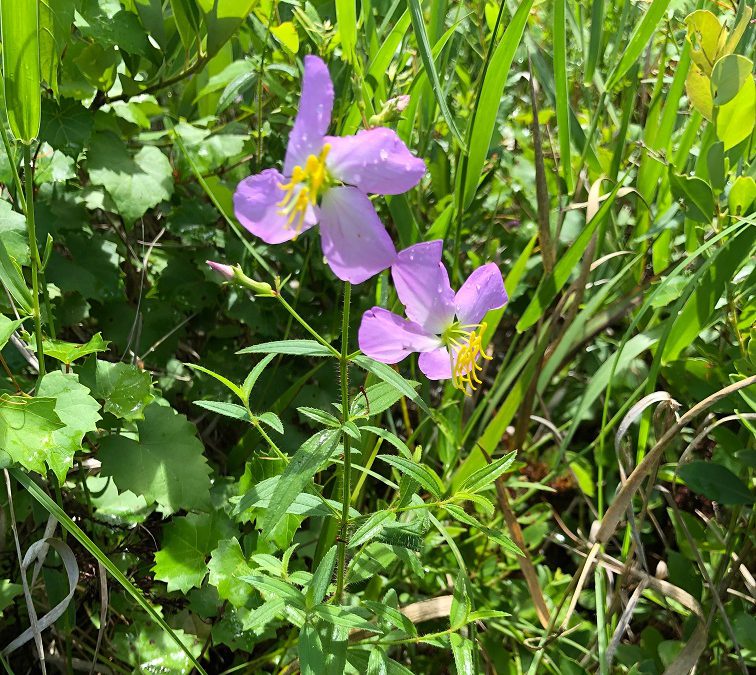
by Stephen Greer | Jul 16, 2020
By: Stephen Greer, CED Santa Rosa County
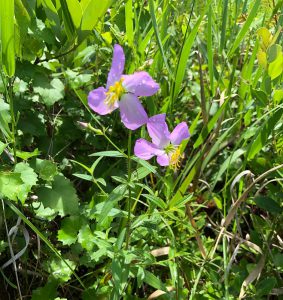
Rhexia marianna Photo credit: Stephen Greer, University of Florid IFAS
There is a lot to be said about early morning or late afternoon walks along a woodland trail in Northwest Florida. With so much to see, hear and smell there is never enough time to take it all in. I would suggest slowing down and look for the many colorful and interesting plants these native plant communities have to offer.
I had the great fortune to meet with a group of plant explores lead by Angus Gholson, botanist and conservationist with a passion to share his knowledge in Washington County many years ago for a 5-hour hiking adventure. We hiked an exceptional longleaf pine forest with immense flora on the forest floor. It was all but impossible to see everything.
We searched for unique and common plants in the Sandhills and Clayhills in the central and northern areas of Washington County. Here are just a few of the plants we saw along our hike and some detail about them.
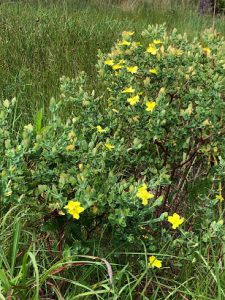
St. Peter’s-wort. Photo create: Stephen Greer University of Florida IFAS
St. Peter’s-wort, Hypericum tetapetalum is a wonderful Hypericum of the many we have in NW Florida. With its ability to repeat bloom petite yellow flowers from March to November, we often get the chance to revisit these trails at a later date for another chance to enjoy them. Like many repeat blooming natives, there will be weeks of rest periods with no bloom. This shrub will grow to three feet tall allowing the flowers to peak out over other plants in the pine flatwoods.
Shiny Lyonia, Lyonia lucida is another exceptional shrub with many uses. This evergreen can grow in low damp areas or with irrigation in landscapes to 10 to 12 feet tall. When found in pine forest areas they range from 3 – 6 feet tall. This Lyonia produces an attractive small bell-shaped red flower spread across a stem of last years growth similar to blueberry. Flowering can occur between November and June.
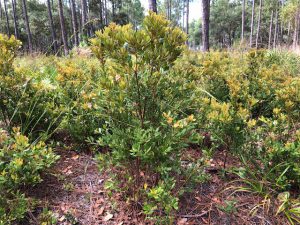
Lyonia lucida. Photo credit: Stephen Greer, University of Florid IFAS
Pale Meadow Beauty, Rhexia Marianna brings a soft pink bloom to the pine forest, grass prairies and edge of full sun to part-shade wetlands. With the ability to grow in diverse landscapes in Northwest Florida it can just about show up anywhere, bloom a few weeks and melt back into the natural setting. Seeding is best completed in the fall and consistent moisture is needed for bloom to occur.
All three of the plants in this article can be found at native plant nurseries. Call the nursery well ahead of time to make sure they either have it or can order it for you. Enjoy the outdoors and adventure it has to offer.
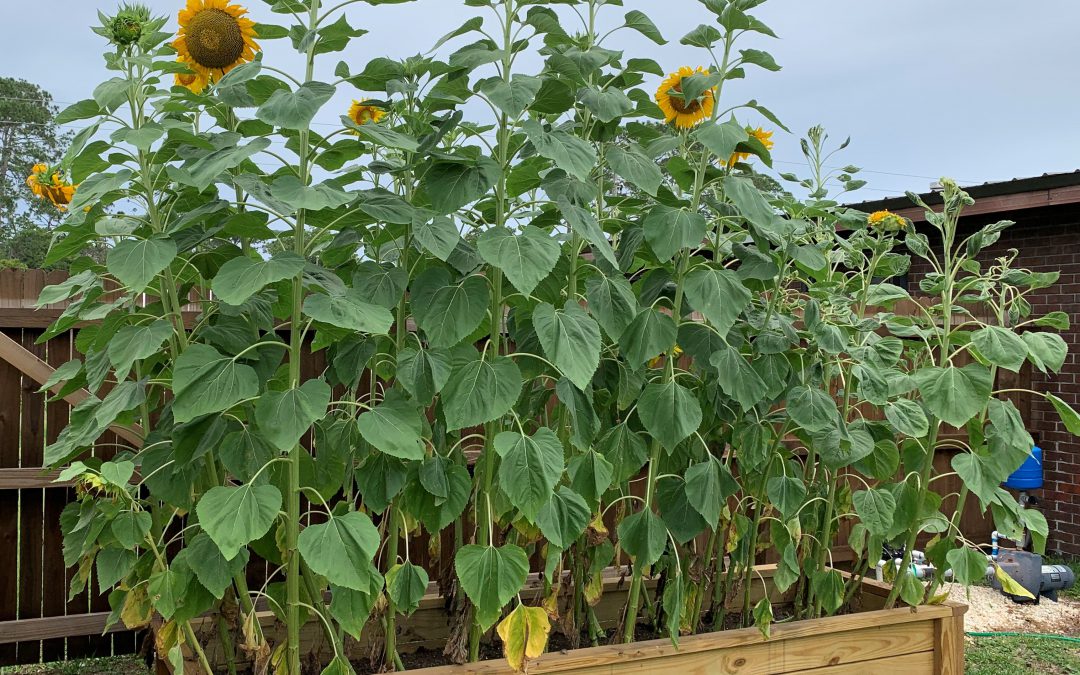
by Ray Bodrey | Jul 1, 2020
Sunflowers, Helianthus spp., are a great choice for gardeners who are looking for some cheerful color in their landscape. Here in Florida, we have the main ingredient for success, lots of sunshine!
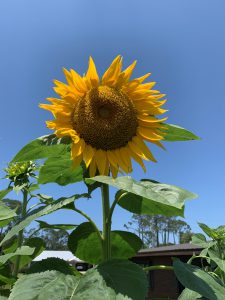
‘Skyscraper’ Sunflower bloom. Photo courtesy of Ray Bodrey.
Sunflowers are short-lived annuals. The average time between planting and bloom is roughly 65 days. You can typically plant sunflowers in Florida beginning in late winter until early fall. Only the coldest months cause problems, and for most years that’s only November – January. Sunflowers can be planted almost anywhere there is full sun. The major selling point with sunflowers is, of course, the impressive blooms (figure 1). These yellow to sometimes orange or red-petaled flowers develop a central seed disc, with most variety’s flowers having approximately an 8” diameter.
When planting, you may choose to plant in narrow rows with close seed spacing in order to cull weaker plants later. A final row and seed spacing of 2’-3’ is recommended for full height and development of most varieties. However, you may also choose to plant in a bed, using a close pattern as seen in the photo below. In any event, sunflowers are easy to propagate by seed and are very low maintenance. Occasionally, powdery mildew and spittle bugs can be a nuisance. A general garden fungicide and insecticide will help if problems occur.

‘Skyscraper’ sunflowers planted on close spacing. Photo courtesy Ray Bodrey.
Sunflowers are available in many varieties, consisting of different color blooms and plant sizes. These sizes range from dwarf (1’-3’) to tall (10’-15’) varieties. You may wish to stake taller varieties at some point, as plants will tend to lean with no wind break in place. Here’s a few garden variety common names to look for: ‘Sunbright’, ‘Sonja’, ‘Sunrich Lemon’, ‘Sunrich Orange’ and ‘Autumn beauty’. Seed companies also have mixes available in packets. For tall plants, ‘Mammoth’ or ‘Skyscraper’ varieties will do the trick.
If you are fond of the sunflower bloom and looking for a groundcover, there are a couple of native perennials that fit this category. Beach sunflower, Helianthus debilis or swamp sunflower, Helianthus angustifolius, are groundcovers/ornamentals for landscapes and thrive in dry, hot climates and in a range of soil types. They also are great pollinator attractors.
For more information on growing sunflowers, contact your local county extension office.
Supporting information for this article and links to other publications on sunflowers can be found at the UF/IFAS Gardening Solutions website: https://gardeningsolutions.ifas.ufl.edu/plants/ornamentals/sunflowers.html
UF/IFAS Extension is an Equal Opportunity Institution.
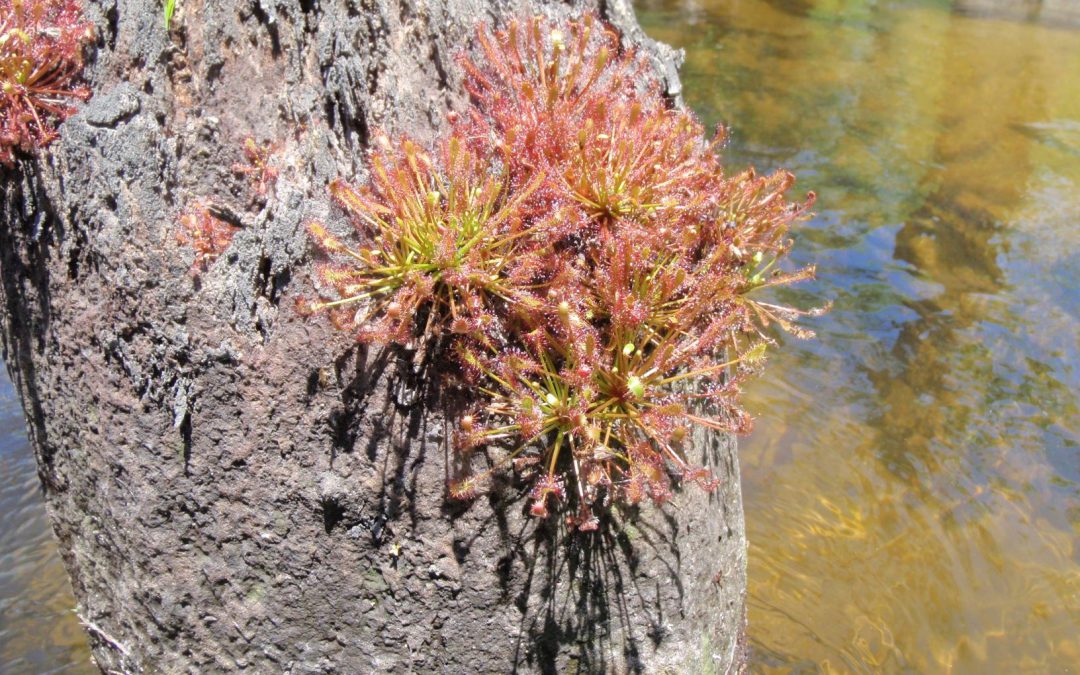
by Carrie Stevenson | Jun 4, 2020
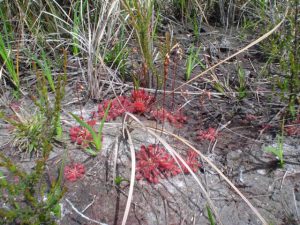
Sundews, tiny carnivorous plants found in pitcher plant bogs, use an enzyme dissolve insect proteins. Native Americans recognized this property and used the plant for skin maladies. Photo credit: Carrie Stevenson, UF IFAS Extension
There are few words better than “pure delight” to describe the face of someone who sees and appreciates a sundew for the first time. Maybe it is their size—often no bigger around than a quarter—or the miniature pinwheel shape, but sundews could easily fit into a fable about garden gnomes or fairies in the woods. These tiny plants hide in plant sight–so small and flush to the ground that you likely won’t see them unless specifically looking for them. But, once you are looking in the right conditions, you will probably see them everywhere.
Sundews (Drosera spp.) are small carnivorous plants found in the same bogs as pitcher plants. They thrive in moist, mucky soil and full sun. They are also carnivorous for the same reasons pitcher plants are—their wet, acidic habitats possess few soil nutrients, so they use insects instead.
Sundews utilize a different method for trapping insects—their flat, radiating structure has wider lobes on the ends, which are covered with hairlike tentacles. These hairs secrete droplets of sticky sap visible at the tip of each hair. Small insects are attracted to the dewlike sap and get stuck. The hairs curl around the insect like a slow Venus flytrap, and natural enzymes to break down the bug.
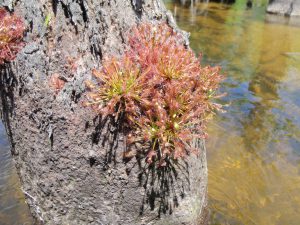
A healthy sundew plant growing just above the water level at Boiling Creek in Santa Rosa County. Photo credit: Larry Burner, Florida Master Naturalist
There are almost 200 species of sundews, not all with the flat growth pattern. The threadleaf sundew has an upright structure, while others may grow in a spherical shape at the water’s edge. While paddling Boiling Creek on Eglin Air Force Base property a few years ago, our group saw dozens of sundews growing on the trunks of cypress and tupelo trees at eye-level from our kayaks. They were about 4-6” in diameter, much larger than the 1” ones we typically see in the bogs.
Tarkiln State Park, Weeks Bay National Estuarine Research Reserve, or any place you find pitcher plants are a great place to find sundews. You may have to get on your knees to see them, and move the grasses aside. Bring a hand lens to magnify the delicate details of the droplets of sap perched at the tip of tiny hairs.
Even the famous naturalist Charles Darwin was enthralled with sundews, conducting experiments and writing volumes about them. In an 1860 letter to his geologist friend Charles Lyell, Darwin stated that, “at the present moment, I care more about Drosera than the origin of all the species in the world.” If you, too, are fascinated with carnivorous plants, check out these resources from UF IFAS Extension and the Botanical Society of America.

by Carrie Stevenson | Jun 4, 2020
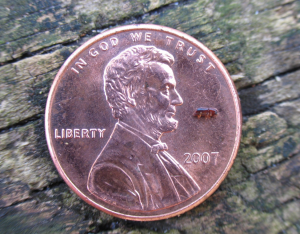
Fig. 1 An adult redbay ambrosia beetle compared to the size of a single penny. Credit: UF/IFAS File Photo.
While most bark beetles are important in forest ecology by recycling fallen dead trees and eliminating sick and damaged trees, some of them may impact healthy trees. A group of bark beetles that has become a major concern to forest managers, nurseries, and homeowners is the ambrosia beetle. Ambrosia beetles are extremely small, 1-2 mm in length, and live and reproduce inside the wood of various species of trees (Fig. 1). Ambrosia beetles differ from other bark beetles in that they do not feed directly on wood, but on a symbiotic fungus that digests wood tissue for them. Every year, non-native species of ambrosia beetles enter the United States through international cargo and we have now nearly forty non-native species of ambrosia beetles confirmed in the United States. Among them, the redbay ambrosia beetle (Xyleborus glabratus), originally from Southeast Asia, is the vector of the fungal pathogen causing laurel wilt, a disease that devastated the Lauracaea population in the southeastern USA, killing millions of redbay, swamp bay, sassafaras and silk bay.
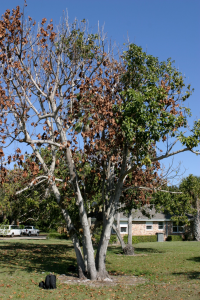
Fig. 2: A mature dooryard avocado tree with large sections of dead and missing leaves, caused by laurel wilt disease. Summer 2009 Impact Magazine image. Credit: UF/IFAS File Photo.
When these beetles attack a laurel tree, the symbiotic fungus is vectored to the tree’s sapwood after the beetle has tunneled deep into the tree’s xylem, actively colonizing the tree’s vascular system. This colonization leads to an occlusion of the xylem, causing wilting of individual branches and in a matter of weeks progresses throughout the entire canopy, eventually leading to tree death (Fig. 2). The laurel wilt disease has spread rapidly after the vector was first detected in Georgia in 2002. The redbay ambrosia beetle was first detected in Florida in 2004, in Duval County, attacking redbay and swamp bay trees. At this point, it is estimated that more than one-third of redbay in the U.S.A., 300 million trees, have succumbed to the disease.
Starting in 2017, we examined the efficacy of verbenone against redbay ambrosia beetle in live laurel trees in a natural forest setting. Verbenone is an anti-aggregation pheromone that has been used since the 1980’s to protect lodgepole pine. Verbenone also has the potential to be used over large areas and is currently being used to protect ponderosa pine plantations from the Mountain Pine Beetle in the western US.
We have found verbenone to be an environmentally friendly and safe tool to prophylactically protect laurel trees against redbay ambrosia beetle. Our protocol consists of the application of four 17 g dollops of a slow-release wax based repellent (SPLAT Verb®, ISCA technology of Riverside, CA) to the trunk of redbay trees at 1 – 1.5 m above ground level (Fig. 3). The wax needs to be reapplied every 4 months during fall and winter and every 3 months during spring and fall when temperature is higher. When compared to the control trees without repellents, we found that trunk applications of verbenone reduced landing of the redbay ambrosia beetle on live redbay trees and increased survivorship of laurel trees compared to untreated trees (Fig. 4). Verbenone should be considered as part of a holistic management system against redbay ambrosia beetle that also includes removal and chipping of contaminated trees.
If you have Redbay or other bay species on your property and are concerned about Laurel Wilt Disease or Redbay Ambrosia Beetle damage, contact your local UF/IFAS Extension Agents for help!
This article is courtesy of Dr. Xavier Martini and Mr. Derek Conover of the UF/IFAS North Florida Research and Education Center (NFREC) in Quincy.

Fig. 3: Application of SPLAT Verb on a redbay tree during a field trial

Figure 4: (A): Cumulative capture of redbay ambrosia beetles Xyleborus glabratus following a single application of verbenone vs untreated control (UC). (B) Survivorship of redbay and swamp bay trees treated with verbenone on four different studies conducted in 2017 and 2018.

by Ray Bodrey | May 13, 2020
Powderpuff mimosa (Mimosa strigillosa), also called Sunshine Mimosa or Sensitive Plant, is an increasingly popular native plant for home and commercial landscape applications that offers a very show display of puffy pink flowers this time of year!

Powderpuff Mimosa, (Mimosa strigillosa). Photo courtesy of Ray Bodrey.
This Florida native, low-growing groundcover grows no more than eight inches in height, and that would be classified as an extremely vigorous stand. Powderpuff Mimosa is technically a perennial legume, meaning it doesn’t need any nitrogen fertilizer from gardeners.
The groundcover is appealing to the eye with its dark green fern-like leaves. Not an evergreen, the plants fall into a semi-dormant to dormant state during the fall and winter seasons. Powderpuff Mimosa is a very resilient groundcover as well, needing little irrigation, spreading quickly, and co-existing well with turfgrass. Just a few pots of this species transplanted should cover up to 300 square feet in a season. Although it spreads quickly, it can easily be pruned or mowed if it moves into unwanted areas.
Powderpuff mimosa is a great plant for erosion control due to its deep roots. These deep roots also allow for good levels of drought tolerance. There are very few insect or disease problems with this plant, other than the occasional caterpillar. It is a very wildlife and pollinator friendly plant, with honeybees, butterflies, deer, and more all finding it appealing. It’s even considered a livestock forage, as cattle find it palatable.
Looking to plant powderpuff mimosa in your landscape? Any area that gets mostly full sun is just fine. This plant is adapted to a wide range of soils, but particularly flourishes in well-drained, sandy loam soils. Be sure to water regularly, especially to ensure successful establishment in your landscape. Find this wonderful little plant at Florida native plant nurseries!
For more information contact the Gulf County Extension Office at 639-3200 or email at rbodrey@ufl.edu.
Supporting information for this article can be found in the UF/IFAS Extension website: https://gardeningsolutions.ifas.ufl.edu/plants/ornamentals/powderpuff-mimosa.html & USDA website: https://plants.usda.gov/plantguide/pdf/pg_mist2.pdf
UF/IFAS Extension is an Equal Opportunity Institution.

















